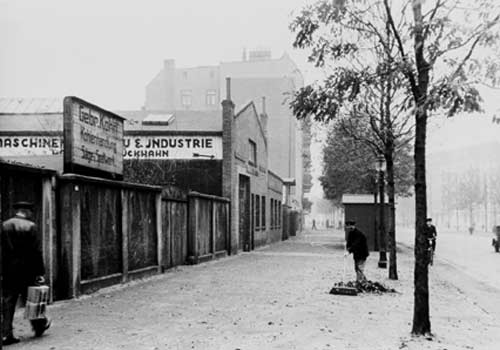Search for Names, Places and Biographies
Already layed Stumbling Stones
Suche
Edith Kohn (née Marqueur) * 1879
Mettlerkampsweg 9 (Hamburg-Mitte, Hamm)
1941 Lodz
1942 Chelmno
ermordet
further stumbling stones in Mettlerkampsweg 9:
Erich Kohn
Edith und Jakob Kohn
Edith Kohn, née Marqueur, born 15 Mar. 1879, deported 25 Oct. 1941 to Lodz
Jakob Erich Kohn, born 18 July 1882, deported 25 Oct. 1941 to Lodz, date of death there 24 Aug. 1942
Mettlerkampsweg 9
The brothers Erich and Siegfried Kohn, born 18 July 1882 and 7 Jan. 1884, were born in Berlin and later lived with their parents, the couple Jakob Julius Kohn and Gütel Henriette, called Auguste Kohn, née Salinger, in Hamburg. The family was Jewish.
Siegfried Kohn married Elsa Kohn, née Levy on 29 June 1916 in Friedrichstadt, Eider. Their only son Hans-Günther Kohn was born in Hamburg on 7 Jan. 1919. Erich Kohn married Edith Marqueur in 1918.
Edith Kohn was born in Lissa, Poland on 15 Mar. 1879. She grew up in Berlin. Her parents, Jakob Marqueur and Henriette Marqueur, née. Landhut, born on 10 June 1852 in Lissa, Poland, had married in Berlin in about 1874 and continued to live there. Edith Marqueur had four siblings. Her father died around 1920. Her mother Henriette Marqueur was arrested by the Berlin Gestapo on 22 July 1942 and deported to Theresienstadt, at the age of 90. She died there on 5 Oct. 1942.
Edith and Erich Kohn gave birth to their son Max Gerd Kohn, born 1 Dec. 1921 in Hamburg. He died as a small child on 8 July 1923.
The brothers Erich and Siegfried Kohn were merchants. On 10 Feb. 1919 they founded a company listed in the commercial register as Gebrüder Kohn Coal Supply and Lumber Mill, Hamburg. The enterprise was located at Eiffestraße 410. Siegfried Kohn lived with his family at Eiffestraße 255 before moving to Dimpfelsweg. Erich lived in "Oben Hamm" Mettlerkampsweg 9. Their nephew Rudi Marqueur, born 26 Jan. 1915 in Charlottenburg, lived with them while he completed his training as an engineer. In 1937 he moved to Cologne and would eventually survive the National Socialist era.
The Kohn brothers earned a good living for both families with their coal and lumber supply and saw mill. They had a good standard of living. The boycott of Jewish businesses from Apr. 1933 then led to considerable loss of income and, ultimately, to the loss of their livelihood.
Elsa Kohn died on 15 Mar. 1937, as her son later wrote, "as a consequence of political and economic upheaval which drove her to take ever greater doses of sleeping pills ".
In 1938 a large part of their office inventory and the operational facilities were violently destroyed. After the so-called Night of Broken Glass (Kristallnacht) in the night from the 9th to the 10th of Nov. 1938, the order was given on 23 Nov. 1938 to eliminate Jews from German economic life. For the Kohn Brothers that meant that they were no longer allowed to carry on with their business that was already weakened by the boycott and destruction. In a letter from 7 Dec. 1938, they officially announced the closure of their business. Ten days later, the coal agent Heinrich Hanser was appointed "Liquidator of the Jewish retail business of the Brothers Kohn, Eiffestraße 410" by designation of Hamburg’s municipal administration. Hanser carried out the liquidation of the company and subsequently applied to have the firm struck from the trade register. It was removed on 24 Nov. 1939. Siegfried Kohn did not live to see that happen; he died on 8 Sept. 1939. His death was, as his son later wrote, "likewise the consequence of the loss of his assets and business, and their ensuing difficulties in living".
After the forced cessation of business at the end of 1938, Erich Kohn together with his wife, his brother Siegfried and his son gave up their previous apartments and moved into a joint apartment on Hansastraße, where he lived until 1940.
In 1939 their nephew Hans-Günther Kohn lost his job and began preparing to immigrate to Palestine at Manor Schniebinchen, Sommerfeld, Lower Lusatia. On 13 Aug. 1940 he immigrated to Palestine, arriving in Nov. 1940. On the ship he met his future wife. They did not marry until 26 Oct. 1943 since Hans-Günther Kohn was arrested immediately upon his arrival by the English mandate power and was interned for approximately two years.
Erich and Edith Kohn were deported on 25 Oct. 1941 from Haynstraße 7 to the Lodz Ghetto. They never returned and were declared dead on 31 Dec. 1945. The Lodz registers recording their arrival, move and notice of departure show that the two of them were assigned a room without a kitchen at Blattbinderstraße 7a/7 on 19 Nov. 1941. The following month in Aug. they moved to another room in the same house with four (!) other people. A few days later, on 24 Aug. 1942, Erich Kohn died. Edith Kohn was deported to the Chelmno extermination camp in Sept. 1942 and killed there.
The household items they left behind were delivered by the company Friedrich Wiese, Schäferkampsallee 16, on 15 Dec. 1941 to the Elsas Auction House, Rödingsmarkt 82. The items were auctioned off for 2337.80 RM, for the benefit of the German Reich.
Translator: Suzanne von Engelhardt
Kindly supported by the Hermann Reemtsma Stiftung, Hamburg.
Stand: October 2016
© Hildegard Thevs mit Bettina Nathan
Quellen: 1; 3; 4; 5; StaH, 522-1, Jüdische Gemeinden, o. Sign. Mitgliederzählung der DIGH 1928; 390 Wählerverzeichnis 1930; 391 Mitgliederliste 1935; 922 e 2 Deportationslisten Bd. 1; AfW 180782; Archivum Panstwowe, Lodz; HA 1933 und 1938.


